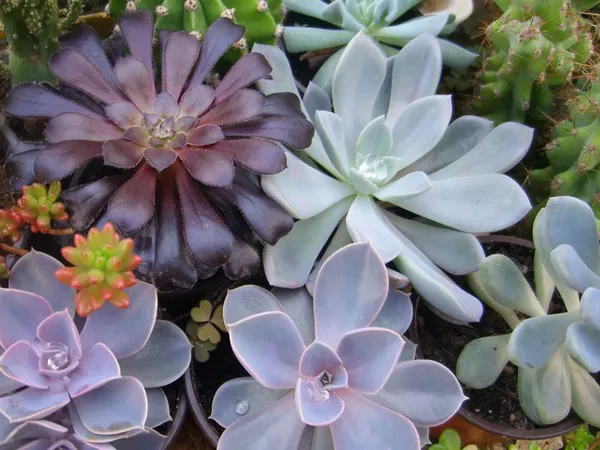Succulents are fascinating and low-maintenance plants known for their striking appearance and versatility. One of the most rewarding aspects of succulent care is propagating new plants from leaves or cuttings. Propagation allows you to expand your succulent collection and share these beautiful plants with friends and family.
Understanding Succulent Propagation
Propagation is the process of growing new plants from existing succulents, and one of the most common methods is leaf propagation. This technique involves taking a healthy leaf or cutting from a mature succulent and encouraging it to produce roots and develop into a new plant. Leaf propagation is not only a cost-effective way to expand your succulent garden but also a way to preserve and share your favorite succulent varieties.
Selecting Healthy Leaves
The first step in successfully rooting succulent leaves is selecting the right ones. To ensure a healthy start, choose leaves that meet the following criteria:
Choose mature leaves: Opt for leaves that are plump, firm, and free from blemishes or signs of damage. Succulents store water in their leaves, so selecting healthy, well-hydrated leaves is essential.
Use leaves from the bottom: Leaves from the lower part of the succulent plant often work best for propagation. These leaves are older and tend to produce more reliable results.
Gently twist the leaves: When removing leaves, gently twist them from the stem to ensure you get a clean break without damaging the leaf.
Preparing the Leaves
After selecting your healthy leaves, the next step is to prepare them for propagation:
Allow the leaves to callus: This is a crucial step in preventing rot during the propagation process. Place the leaves in a dry, shaded area for a few days to allow them to callus. The callused end will be the side that you plant in the soil.
Remove the leaf cleanly: Ensure that the leaf is separated from the stem without any remaining fragments. A clean break helps in preventing infection and encourages root growth.
Choosing the Right Soil
Succulents thrive in well-draining soil, and this holds true for leaf propagation as well. It is essential to use a specialized succulent or cactus mix or create a DIY mix by blending potting soil with sand or perlite. The well-draining soil provides the right balance between moisture retention and aeration, crucial for root development.
Planting the Leaves
Once your leaves are ready and you have prepared the suitable soil mix, it’s time to plant them:
Use small pots or containers: Choose containers that are appropriately sized for your leaves. Small, shallow pots work well for this purpose.
Plant the leaves: Gently insert the callused end of the leaf into the soil, burying it just enough to provide stability. Make sure not to bury the entire leaf, as the buried part might rot.
Maintain proper spacing: Ensure that the leaves are not too close to one another to allow for good airflow and prevent overcrowding.
Light and Temperature Conditions
Succulent leaves need the right light and temperature conditions to root successfully. Here are some key considerations:
Indirect sunlight: Place your pots in an area with bright, indirect sunlight. Avoid placing them in direct sun, as intense sunlight can scorch the leaves.
Warm temperatures: Succulents thrive in warm temperatures, so ensure your propagation area is kept at temperatures between 65°F to 75°F (18°C to 24°C). Avoid exposing the leaves to extreme cold or heat.
Watering Techniques
Rooting succulent leaves requires a delicate balance when it comes to watering. Follow these watering guidelines:
Mist sparingly: Initially, you can mist the soil to keep it slightly moist. After planting, allow the soil to dry before the next watering, ensuring that the leaves do not sit in water.
Avoid overwatering: Overwatering is a common mistake in succulent propagation. Be cautious not to saturate the soil, as this can lead to rot. Instead, mist lightly to maintain a humid environment.
Patience and Monitoring
Succulent propagation is a slow process that requires patience. It can take several weeks to months for roots to develop and new plants to form. Here are some tips for monitoring and caring for your propagating succulent leaves:
Check for roots: Gently tug on the leaf after a few weeks to check for root development. If there are roots, the leaf will resist being pulled out.
Be patient: Some succulents may take longer to root than others, so it’s important to be patient and continue to monitor progress.
Transplanting New Plants
Once the succulent leaf has produced roots and new plantlets, it’s time to consider transplanting them into individual pots or your succulent garden. Follow these steps for a smooth transition:
Gently remove the new plantlets: Carefully detach the rooted leaves from the original leaf, ensuring you don’t damage the roots.
Use the right-sized pot: Choose pots that allow room for the new plant’s growth and provide the appropriate environment.
Plant in well-draining soil: Transfer the new plantlet to well-draining soil, similar to the one used for leaf propagation.
Conclusion
Succulent leaf propagation is a rewarding and enjoyable way to expand your succulent collection and share the beauty of these unique plants with others. By carefully selecting healthy leaves, providing the right conditions, and monitoring the progress of your propagating succulent leaves, you can enjoy the satisfaction of nurturing new succulent life. With a little patience and dedication, you can create a thriving succulent garden that brings joy and tranquility to your living space.


